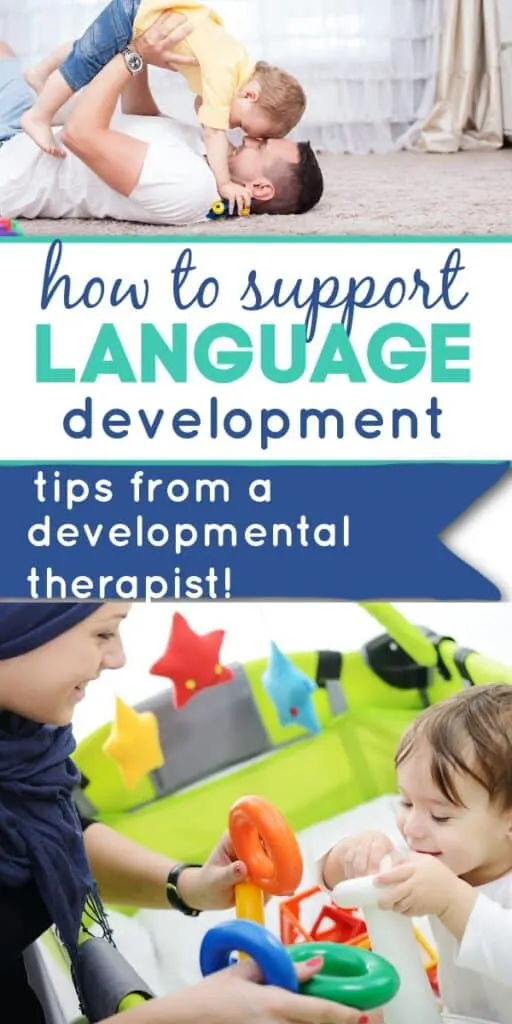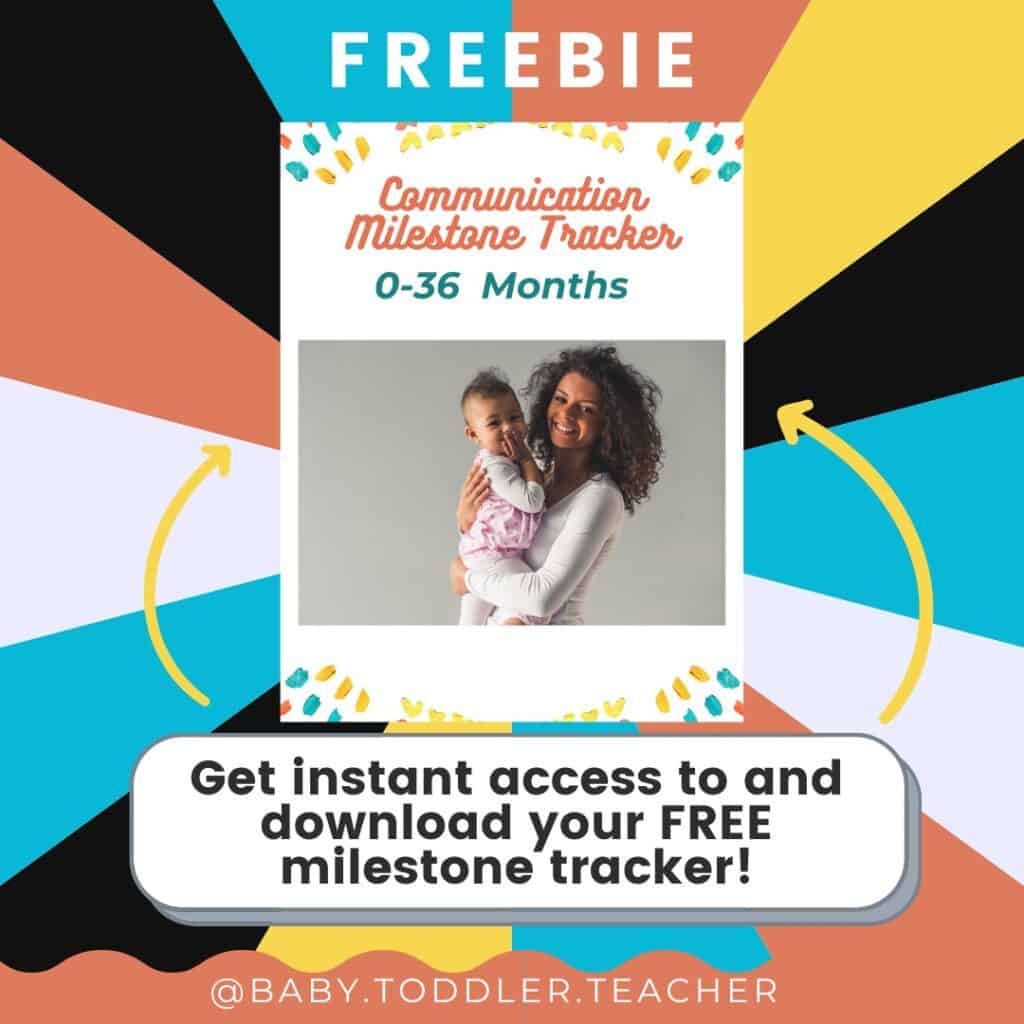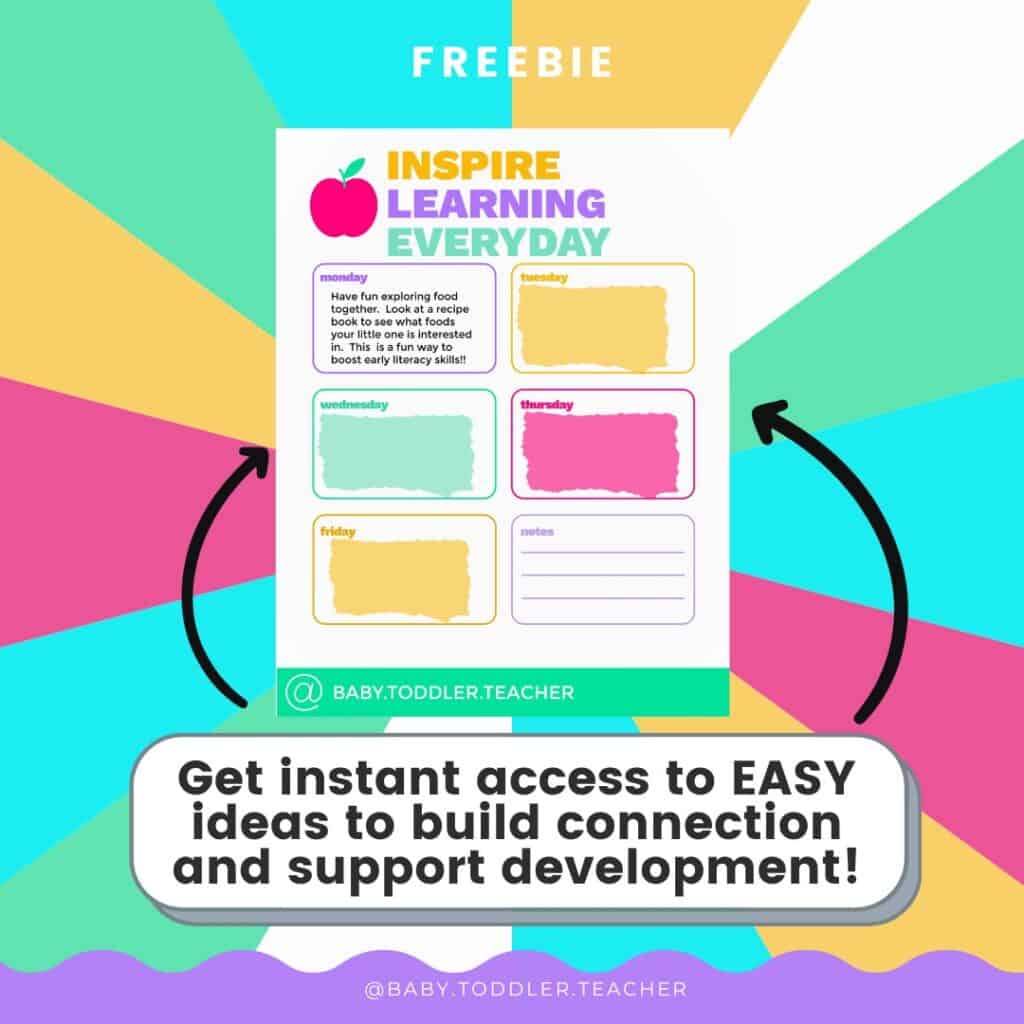If you’re looking for simple ways to encourage toddler language development, you’re in luck!
This post outlines 8 easy ways to support receptive and expressive language skills.
Even better, these strategies are easy to incorporate into playtime and daily routines.
So get ready to help your little one blossom into a confident communicator!
If you are new to my blog, my name is Kayla and I have been working with babies and toddlers in early intervention for many years and these are some of my favorite tips!

1. Make Singing Part of Your Day
One fun and easy way to support language development is to sing with your toddler.
Fostering communication skills in toddlers is a crucial aspect of their cognitive development, and singing emerges as an excellent way to accomplish this.
For toddlers, the act of singing songs and nursery rhymes is not only enjoyable and motivating but also a valuable tool that allows them to hear and practice vocabulary repetitively.
This repetition is a key factor in growing a child’s vocabulary, as it helps them to learn new words.
Incorporating singing into everyday interactions and routines, such as diaper changes or transitions, provides an opportunity for toddlers to associate words with their corresponding actions.
This strategy supports their learning process, helping them understand the meaning and application of words in different contexts.
Harnessing the power of song is a practical and effective method to boost a toddler’s communication skills.
It’s a method that is easily integrated into a child’s daily routine, making it an excellent way to promote language development in young children.
2. Use All Types of Words With Your Child
Another way to support language development is to use a variety of words with your child.
Talk about what you’re doing as you’re doing it.
For instance, if you’re cooking dinner say “I’m chopping up these vegetables” or “I’m stirring this soup.”
Not only does this help build vocabulary, but it also gives them a way to be a part of what you are doing.
There are so many opportunities for your little one to learn throughout the day when we are mindful.
Don’t shy away from using descriptive words as they are just as important!
I love to target descriptive words when reading books with my toddler as well.
For example, if we’re reading a book about dogs I might say “The dog is brown and has a curly tail.”
This not only helps with speech skills but it also helps with vocabulary and general knowledge.

3. Use Gestures When Speaking, Not Just Words
Pairing gestures with spoken words presents another valuable strategy for facilitating language development in young toddlers.
This nonverbal communication aids in making the connection between simple words and their meanings more tangible for toddlers.
Actions and movements can often be imitated more easily than spoken words, lending further support to this learning method.
When a child sees a gesture associated with a word, they gain another layer of context that helps reinforce their understanding.
For instance, waving while saying “goodbye” helps a toddler associate the action with parting.
Importantly, teaching your child gestures also opens up an avenue for them to communicate before they can fully articulate words.
This early form of communication can alleviate frustration and build a foundation for language development.
It also works well for helping build receptive language skills as well.
These are the skills your toddler needs to listen and follow simple directions.

4. Don’t Skip Animal Sounds!
We oftentimes get so excited for those first words that we sometimes forget the importance of sounds!
Sounds are usually easier for your child to imitate than words and they are motivating because they are usually a bit silly.
If your child seems to be imitating play actions and gestures well then it is time to start working on sounds.
Some examples of sounds that you can start with include:
- Silly Sounds (make them up as you go!)
- Animal Sounds
- Environmental Sounds
You can model these for your child during daily routines, playtime, or while reading books.
5. Children Learn New Words Through Books
Using books as a tool for encouraging language development is a highly effective approach, nurturing both expressive and receptive skills.
Picture books, filled with a variety of simple words, allow children to explore language visually and engagingly.
You can label images, improving children’s vocabulary and comprehension.
You can also use different voices to make the reading experience more dynamic and engaging.
Encouraging children to name pictures they recognize not only reinforces their literacy skills but also boosts their confidence.
Following the child’s lead when examining a book respects their interests and promotes independent learning.
This approach fosters a language-rich environment, which is key in building a toddler’s vocabulary.
Furthermore, incorporating simple instructions during the reading process can enhance your child’s ability to follow directions and comprehend language.
Beyond books, environmental print, such as food packaging, can also be a valuable language-learning resource.
Reading and language activities should not be confined to book reading alone but should extend to multiple activities and daily routines.
6. Provide Opportunities for Your Toddler to Communicate
Do you know your child so well that you know what they want most of the time even if they can’t say the words?
As parents, we know our little ones so well that we can sometimes predict their needs.
This can be a great thing…but it can also sometimes cause us to not give them the opportunity to communicate.
Instead of just getting your child crackers at snack time because you know they are probably hungry, give them the opportunity to communicate.
Simply ask them “What do you want?”
Then watch for their cues.
Can they point, gesture, or vocalize to indicate what they want?
If open-ended questions are not working try just using a simple choice between two options.
This counts as communication and you need to support your child wherever they are at.
Once you have figured out what they want based on the clues they gave you, then model the words and give your child what they want.
You can watch this short clip if you need an example.

7. Get Those First Words Using Repetition
One of the most important things for a child’s language development is repetition!
They need to hear words over and over again in order to pick up new speech sounds and words.
Using target words can be a great way to get that repetition into your day.
For example, during your child’s next meal, I want you to say the food they are eating at least 3 times!
Here is how this looks:
- Offer a choice and label it
- Lable it again once they have picked what they have wanted
- Label again as you give your child the food
You can see a video example of this here.
8. Utilize the Power of the Pause
Pausing is at the top of my list when it comes to SIMPLE things you can do as a parent to encourage language development.
I love to start playing with pauses while singing familiar songs or reading your child’s favorite books.
If you have sung a song 93849404 times…then there is a chance that your little one might be able to fill in the blank with a word because they know it so well.
This is what it could look like:
The itsy bitsy spider went up the water spout
Down came the rain and…PAUSE…
Wait just a bit and see if your child attempts to fill in the blank.
At first, they may only fill in with a vocalization, but give it some time and it may turn into an actual word!
Here is an example using it with songs and objects!

Want more ideas and strategies to try?
Fostering language development in toddlers is a process with opportunities present in our everyday routines.
Parents can introduce ‘body parts’ through playful activities and interactive games, turning a regular ‘bath time’ into a fun and educational experience.
Experimenting with ‘different ways’ of communication, such as songs, stories, and toys, can stimulate a child’s interest in language.
Observing and reacting to ‘facial expressions’ will further aid toddlers in understanding non-verbal cues, which is a critical aspect of effective communication.
By integrating these simple yet effective strategies into your daily interactions, you can significantly enhance your toddler’s language development.
If you would like more ideas like this make sure to check out my 1 MInute Communication Idea Cards or get all of my parenting resources when you sign up to my group for mindful parents of babies and toddlers!
Frequently Asked Questions
There are many things parents can do to support toddler language development.
Some simple strategies include reading stories, providing opportunities to communicate, and using repetition.
Parents can also get creative with pauses while singing familiar songs or reading their child’s favorite books.
The benefits of supporting toddler language development are many.
Some include improved communication, increased vocabulary, and better speech clarity.
All of which contribute to a child’s overall language development.
Music can be a great way to support language development because of the natural repetitiveness that occurs in children’s songs and fingerplays.
Singing can be built into almost any routine so it can be a great tool for parents trying to support language development.
If you have concerns about language delays then it is best to reach out to your state’s early intervention program so that you have a screening or evaluation completed to assess your child’s development.
As your child gains new words they may be a bit hard to understand at first which is normal.
You can improve speech clarity by repeating what your child says and modeling for them the correct way of saying the word.
We can also get practice by reading stories and singing songs that have lots of repetition.
Related Posts You Will Enjoy
Toddler Motor Skills: Everything You Need to Know About Motor Development
7 Easy Chores for Toddlers that Just Make Sense!
The Best Non-Toy Gifts for Toddlers
Toddler Magazines Your Little one will LOVE!


Kayla O’Neill has a master’s degree in education as well as a bachelor’s degree in special education with an emphasis in early childhood education. She has been working as a developmental therapist with babies and toddlers in early intervention since 2012. She is also a mom with two young children.
